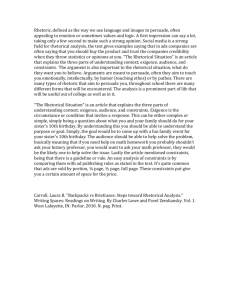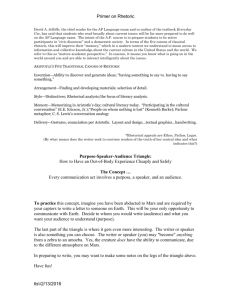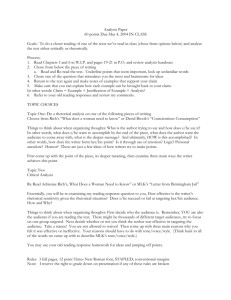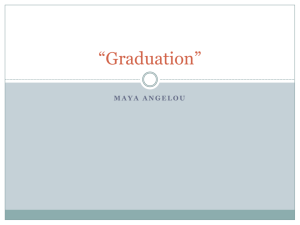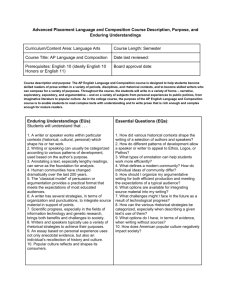File
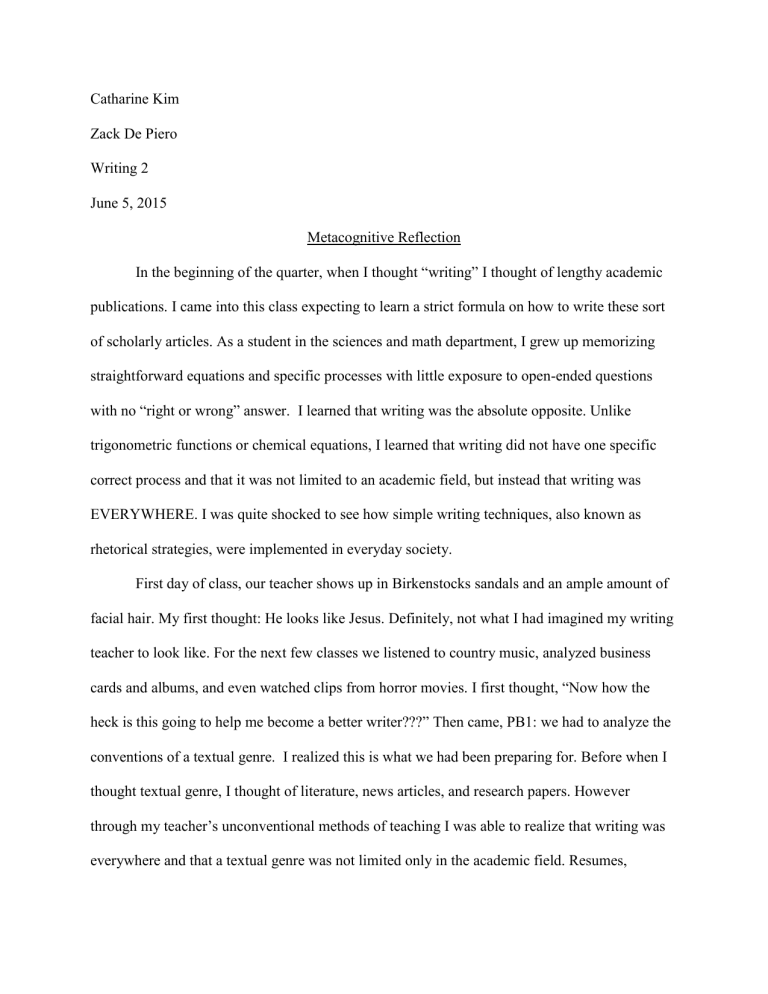
Catharine Kim
Zack De Piero
Writing 2
June 5, 2015
Metacognitive Reflection
In the beginning of the quarter, when I thought “writing” I thought of lengthy academic publications. I came into this class expecting to learn a strict formula on how to write these sort of scholarly articles. As a student in the sciences and math department, I grew up memorizing straightforward equations and specific processes with little exposure to open-ended questions with no “right or wrong” answer. I learned that writing was the absolute opposite. Unlike trigonometric functions or chemical equations, I learned that writing did not have one specific correct process and that it was not limited to an academic field, but instead that writing was
EVERYWHERE. I was quite shocked to see how simple writing techniques, also known as rhetorical strategies, were implemented in everyday society.
First day of class, our teacher shows up in Birkenstocks sandals and an ample amount of facial hair. My first thought: He looks like Jesus. Definitely, not what I had imagined my writing teacher to look like. For the next few classes we listened to country music, analyzed business cards and albums, and even watched clips from horror movies. I first thought, “Now how the heck is this going to help me become a better writer???” Then came, PB1: we had to analyze the conventions of a textual genre. I realized this is what we had been preparing for. Before when I thought textual genre, I thought of literature, news articles, and research papers. However through my teacher’s unconventional methods of teaching I was able to realize that writing was everywhere and that a textual genre was not limited only in the academic field. Resumes,
recommendation letters, diary entries, and menus were all textual genres! This became the first point I learned from this class: the importance of writing was shown not only in an academic field, but also in everyday life.
The second point I learned from this class was the importance of understanding rhetoric.
Rhetoric is defined to be the way we use language to persuade, or as one of the professors in the video we watched puts it, “BullSh*t”. I’ve realized that writing would be pointless if there was no purpose. As said in Everything is an Argument , written work will have a purpose: to inform, convince, explore, or even to pray. And to be effective in achieving this purpose, the author must make use of rhetorical “moves”. I learned that as a writer it is important to decide which moves to incorporate into his or her writing. I found the reading Backpacks vs. Briefcases: Steps toward
Rhetorical Analysis by Laura Bolin Carroll to be the most helpful. Caroll shows authors can use emotion, logic, or even exaggerated language to persuade their audience effectively. Seeing all those different rhetorical mechanism helped me expand my “bag-of-tricks” to use to be a more effective writer as well.
Understanding these two key points helped me read like a writer, and see through the effects of rhetoric. Going back to my WP1 and WP2, I saw that I had more so given an explanation of what the writers did rather than to analyze why they did what they did.
For example using this sentence:
“The cat was peacefully enjoying its day when it was brutally attacked by the horrid bird.”
In the beginning of the quarter I would have said, “The author used strong language to persuade the audience that the bird was bad.” But after learning to read like a writer I was able to identify why the author decide to make that move and say, “The author used strongly connoted language
to instill emotion into the audience. By using pathos, the author was able to persuade the audience to think badly of the bird. Analyzing the rhetorical strategies used by these writers not only helped me understand academic texts but also taught me to be more aware. This might seem a strange lesson to be learned from a writing class (and I am not sure that this was an intentional lesson) but I learned to see not only through academic texts but also through ALL texts. Using that previous example, I see that the purpose of that sentence was to make the audience dislike the bird. However, that was only due to the rhetorical moves the writer added. What if it was written another way?
“The mother bird bravely fought off the ignorant, giant cat that was about to stomp on the nest.”
I learned that as important as the information is, HOW it is written greatly matters. This could be tied into everyday life. It has me questioning how other rhetorical moves were made to spin ads and even newspaper headlines were written to appeal to the audience.
Aside from textual genres and rhetoric, I especially learned and used a lot of the writing and process tips! (I do wish we had more of those!!!) The grammar tips, such as use of the oxford comma, hyphens, and parallelism were definitely helpful. However, I really enjoyed the tips on the process of writing. I found changing the font to be a great and simple solution to writing. It makes the writing FUN because I want to see more of this funky font going across the paper. I am currently writing in a font called “Gabriola” and it looks like fancy wedding napkin writing. (
SEE LOOK this is so fancy
.) Another writing process tip that I implemented was the use of reverse outlining. For WP1, I thought that I had organized my essay quite well. In the journal, when asked how I wrote my WP1, I said, “I did an outline and then divided the essay by sources.
I talked about what conventions were included in source 1, 2, and 3 in different paragraphs, and then a concluding paragraph on the similarities and differences among the sources.”(Journal
April 13,2015) I did not think to do a reverse outline to make sure that there was a good flow to the essay. However by WP3 I understood that a better way to write would be to compare ideaby-idea rather than source-by-source. I was able to check that the essay coherently flowed when I could make a reverse outline that clearly stated one sentence that explained what that paragraph was about. Another lesson that I learned (although I probably should have done from before) is that although your first draft is a rough draft, your rough draft is not limited to your first draft. I learned that I should have my very shitty first draft, then my kind of less sucky second draft… all the way to your final draft. I have a very “I WILL DO IT” personality. I have trouble skipping questions on a test and coming back to it later because I feel I need to answer it/I will figure it out now. Just as in writing, when I get stuck, I would sit there staring at the blinking cursor until
I could come up with a satisfying sentence. I now realize how that there are better solutions than pulling hair in frustration until I spit out that one sentence. I learned that sometimes not knowing right now is OK. I can leave a bunch of in place and come back to it after I finish that draft.
I ended this quarter learning things that I didn’t think I would learn from this class. I came in expecting to be taught strict lessons by a 50-year-old man in a button-up and khakis on what a body paragraph should look like or being assigned a ton of grammar worksheets. Instead I learned the importance and applications of textual genres and rhetoric not only in the academic field also in everyday life. The unconventional methods used in this class actually turned out to be the most helpful and applicable to real-world examples.
Works Cited
“Reading and Understanding Arguments: Everything is an Argument”, Writing 2 De Piero
UCSB reader , Spring 2015. Page 77.
Laura Bolin Collin. “Backpacks vs. Briefcases: Steps toward Rhetorical Analysis”, Writing 2 De
Piero UCSB reader , Spring 2015. Page 61.
My journal
& Lots of things you said
(THANK YOU for making this class not like any other typical college classes)

